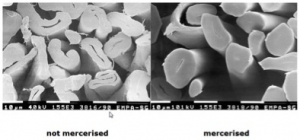The initial process was developed in 1844 by John Mercer (Lancashire, England), who treated cotton fibres with sodium hydroxide, but without neutralising the alkaline with acid. This treatment caused the fibres to swell, making them stronger and easier to dye, but at the same time they shrank making it difficult to spin the fibres into a thread.
Mercerisation was not a popular process until in 1890 Horace Arthur Lowe improved the technique by preventing the cotton fibres from shrinking, by adding the neutralising acid. This form of mercerisation continues to be used into the twenty-first century.
Source: TORTORA, Phyllis G. and Ingrid JOHNSON (2014). The Fairchild Books: Dictionary of Textiles, 8th edition, London: Bloomsbury, p. 380.
Digital source of illustration (retrieved 26 June 2016).
GVE

